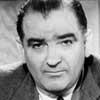Reading Quizzes
Available to teachers only as part of theTeaching Cold War: McCarthyism & Red ScareTeacher Pass
Teaching Cold War: McCarthyism & Red ScareTeacher Pass includes:
- Assignments & Activities
- Reading Quizzes
- Current Events & Pop Culture articles
- Discussion & Essay Questions
- Challenges & Opportunities
- Related Readings in Literature & History
Sample of Reading Quizzes
Big Picture
Questions1. Why was there potential for liberal reform at the end of World War II?
2. What was Harry Truman's vision of the future of America?
3. How did the Cold War change the way Americans viewed liberal reform?
4. How did the Cold War change the way Americans viewed liberal reform?
5. How did Communists' role in American society change due to the Cold War?
Answers
1. In many ways, conditions appeared ripe for liberal success. Many of the ideologies of the extreme right wing—white supremacy foremost among them—had been adopted by the Nazis, and were thus seriously discredited. Meanwhile, the unusual demands of wartime production had allowed women and racial minorities to enter the workforce in unprecedented numbers and labor unions were at an all time high.
2. In August 1945, Truman proposed to Congress an expansive 21-point agenda that included a higher minimum wage, expanded Social Security system, new public works programs, full-employment guarantees, and universal national health insurance. Truman's proposals, if enacted, would have pushed far beyond the limits of the New Deal to begin to create something like social democracy in the United States. However, the Cold War soon changed how the United States approached politics.
3. Up until 1945, the Communists' minority presence within many New Deal-era reform groups was usually an issue that could simply be overlooked. With the dawn of the Cold War, however, everything changed. Suddenly, as the Soviets quickly transformed from uneasy allies to menacing enemies, the presence of Communists within American society became much more problematic, especially for liberals. The Communist problem split America's liberal community, opened the door for rollback of parts of the New Deal, and derailed Truman's hopes for expansive new reform initiatives in the postwar era.
4. Up until 1945, the Communists' minority presence within many New Deal-era reform groups was usually an issue that could simply be overlooked. With the dawn of the Cold War, however, everything changed. Suddenly, as the Soviets quickly transformed from uneasy allies to menacing enemies, the presence of Communists within American society became much more problematic, especially for liberals. The Communist problem split America's liberal community, opened the door for rollback of parts of the New Deal, and derailed Truman's hopes for expansive new reform initiatives in the postwar era.
5. The antagonism of native-born, white Protestants toward the perceived cultural excesses of the "Roaring Twenties" fueled a political backlash that allowed a resurgent Ku Klux Klan—anti-black as always, but now also anti-immigrant, anti-Catholic, anti-Semitic, anti-evolution, anti-drinking, and anti-sex—to take over several state governments.
